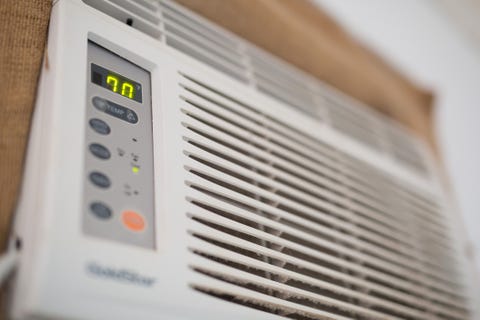How to Install Wall Air Conditioner in Window
There's no simpler, more affordable way to cool down a room than with a window-mounted air conditioner. These compact units are reliable, durable, able to cool virtually any size room, and today's models are exponentially more energy efficient than units built just 10 years ago. Plus, window air conditioners are easy to install.
🛠You love fixing stuff. We love fixing stuff. Let's do it together.
Here, I'll share some tips on what to consider when buying an air conditioner, and then how to install it securely and remove it for winter storage.
Size the Room
Window-mounted A/C units come various sizes and cooling capacities, ranging from about 5,000 BTU to 25,000 BTU (British thermal units). As a general rule, you need about 20 BTU of cooling for every square foot of living space. So, for example, a 12x16-ft. room would require an air conditioner with a cooling capacity of approximately 4,000 BTU (12 x 16 = 192 sq. ft. x 20 = 3,840 BTU).
Here's a simpler, no-math way to determine which size air conditioner to buy. Listed below are the most common sizes of window air conditioners for rooms ranging from 150 to 1,600 square feet:

Staff
It's critically important to choose a model with a cooling capacity sufficient to cool the room. If you choose a unit that's too small, it'll struggle to keep the room cool on the hottest days. And choosing a unit that's too big—a common mistake—is just as problematic.
An oversized air conditioner will pump too much moisture back into the room, raising the humidity to unsafe levels, especially for those with breathing difficulties. Excessive moisture can also create a breeding ground for dust mites and mold. Plus, a too-big A/C unit is louder and burns more electricity than a properly sized unit.
Buy the Best
If you're looking for a new window A/C, well, you're in luck.

Quietest
Serenity Series Quiet Window Air Conditioner (6,000 BTU)
This compact model from Haier is one of the quietest and most energy-efficient window air conditioners on the market.

Most Convenient
Smart Room Air Conditioner (8,000 BTU)
GE Appliances is the first to announce voice-enabled air conditioners, so you can turn these units on and off or adjust the temperature without leaving your couch.

Best Performance
Window A/C (8,000 BTU)
Designed to quickly cool large spaces, this high-performance, 8,000 BTU LG window air conditioner is ideal for rooms up to 17 x 20 feet.

Best Design
Smart Window A/C (10,000 BTU)
This Energy Star–rated Frigidaire is one of the best-looking window-mounted air conditioners we've seen.
Summer might be hot, but so is the competition to sell these appliances, with anywhere from 1.74 million to 5.4 million being sold in any given year recently, according to statista.com and U.S. Department of Energy.
That competition helps you, as manufacturers hold down prices and outbid each other to add features such as voice control, app control, hand-held remotes, timers, and features like a dehumidifier setting. Bells and whistles are nice, but more so is the increased energy efficiency of these appliances.
Check Your Window
Most window-mounted air conditioners are designed to fit into double-hung windows, but most units can also be placed in swing-out casement or sliding windows. (Check with the air-conditioner manufacturer for specific installation instructions.) Here, I'll discuss installation for double-hung windows, which are by far the most popular style of window.
Start by raising the lower sash, and then measure the height and width of the opening. Be sure to have those dimensions on hand when shopping for an air conditioner to ensure it'll fit comfortably into the window. Also, keep fire safety in mind when deciding where to install the air conditioner: Don't place it in an egress window that serves as the only means of escape should a fire erupt.
Consider Energy Efficiency
The energy efficiency of a room air conditioner is designated by its EER number, which stands for Energy Efficiency Rating. The EER is calculated by dividing the unit's BTU rating by the wattage of the unit. For example, a 12,000 BTU air conditioner that uses 1,200 watts of electricity has an EER of 10.
⚠️ Don't confuse EER with SEER—Seasonal Energy Efficiency Ratio—which is used to calculate the energy efficiency of central air-conditioning systems.
Window A/C units typically have ratings between about eight and 12. A rating of 10 or higher is considered ideal for saving electricity and lowering your utility bills. And be sure to look for features such as digital temperature controls, variable fan speeds, and sleep settings, which also can help conserve power.
Installation
Installing a window air-conditioner is best done with two people. Even small air conditioners are heavy and awkward to lift. And the last thing you want is for your A/C unit to fall out window or onto the floor.
💡 Save the air conditioner's original box and packing materials; you can use it later for storing the unit.
Start by reading the installation manual and familiarizing yourself with all the included hardware and fasteners. Most units come with a kit that includes adjustable window extensions and metal mounting brackets. These parts will ensure a secure and airtight fit in the window opening. And for additional support, especially for larger air conditioners, consider purchasing a steel support bracket and mount it to the outside house wall, directly below the windowsill.
Raise the window's lower sash and set the A/C unit centered on the windowsill. Most the weight will be hanging out the window, so be sure to keep a firm grip on the unit. Now pull down the lower sash until it contacts the top of the A/C unit directly behind the metal flange running across the top of the unit. Keep downward pressure on the lower sash; it's preventing the unit from toppling out the window. The installation kit typically includes two small L-shaped metal brackets, which are used to prevent the lower sash from being raised.

Marius Hepp / EyeEm Getty Images
Set one bracket on the far left, top edge of the lower sash. Then, use a cordless drill to screw the bracket to the upper sash. Repeat to install the remaining bracket to the far right side of the lower sash. Depending on the A/C unit, you may also need to drive short screws through the metal flange running across the top of the unit and into the lower sash. With the brackets screwed in place and the lower sash locked in positioned, and the A/C unit is secured.
Next, attach the two accordion-like extensions, one to each side of the A/C unit. (Note that in some cases you must install the extensions prior to setting the unit in the window; check the installation manual for specific details.) Pull out each extension to close off the space to the left and right of the air conditioner. Screw the vertical mounting flange of each extension to the window jambs. Take the thick foam-rubber weather stripping and stuff it into the gap along the top edge of the lower sash to block out insects and hot air.
When properly installed, the A/C unit will tip slightly to the outside. This is important to allow condensation to drip outside, not into the room.
Power It Up
Air conditioners draw a fair amount of electricity, so be mindful of the circuit into which you plug the unit. If the same circuit powers other high-energy appliances—refrigerators, dryers, ovens—consider plugging in the air conditioner elsewhere. If you're using an extension cord, it's important to use a cord that's specifically designed to handle the electrical load; these heavy-duty cords are usually labeled as, "air-conditioner cord" or "major-appliance cord."
And be sure to check the air filter monthly throughout the cooling season to ensure it's clean and clear of obstructions.
Removal for Storage
Removing a window air-conditioner unit can be difficult, so unless you really need access to the window or want to create a better seal for winter, it's best to leave it in place and protect it with a slip-on cover.

imagedepotpro
If you decide to remove the air conditioner, again, it's best to have two people. Start by reversing the installation steps, but be very careful not to unscrew the two small L-shaped brackets until you've slid the air conditioner into the room far enough so that it's resting securely on the windowsill and not tipping in or out.
After removing all the hardware, raise the lower sash and lift the air conditioner out of the window and set it onto a thick blanket spread on the floor. Vacuum the outside of the unit—especially the louvered vents—and then wipe it down with a damp cloth.
Place the air conditioner back into its original box, using the dense-foam packing material to protect it from damage. Put all the screws, brackets and other installation hardware items in a re-sealable plastic bag, and put the bag in the box. Set the box in a cool, dry place for the winter. And if the storage room has a concrete floor, place two 2x4s beneath the box to raise it up and protect it from moisture.
Watch This:
Timothy Dahl DIY Editor Timothy is a lifelong DIY enthusiast who is fixated on smart home tech, beautiful tools, and wrenching on his FJ62 Land Cruiser.
Joseph Truini Joe is a former carpenter and cabinetmaker who writes extensively about remodeling, woodworking, and tool techniques.
This content is created and maintained by a third party, and imported onto this page to help users provide their email addresses. You may be able to find more information about this and similar content at piano.io
How to Install Wall Air Conditioner in Window
Source: https://www.popularmechanics.com/home/how-to/a6030/how-to-install-a-window-air-conditioner/
0 Response to "How to Install Wall Air Conditioner in Window"
Post a Comment